 |
| Home │ Guitar
Home Page |
Copyright © 2018 by Wayne Stegall
Created March 15, 2018. See Document History at end for
details.
Straight Intonation
Calculate
the
approximate
intonation
error
of
an intonation with a straight nut
and saddle.
Introduction
If the intonation correction at the nut and saddle is different for every string on a guitar, then the straight nut and saddle of most guitar setups are a compromise. I thought it might be interesting to estimate how much error is present in these setups and whether it is reasonably audible. The custom compensation is assumed perfect then each alternative intonation is calculated for error in mm and then in cents. Cents are an exponential percentage calculation tailored to representing frequency error. 100 cents = 1 semitone. The reader is then to infer an approximately linear and/or inversely-linear relationship between changes in string length and the associated frequencies.As a point of reference it may be reasonable to think the error introduced by equal-temperament tuning relative to perfect harmonic tuning (just temperament) is tolerated by music listeners. Therefore I have calculated this error and presented it in table 1 below.
| Table
1:
Equal-temperament
error
for
common
intervals |
||||||||||||||||||||||||||||||||||||||||||||||||||||||||||||||||||
|
Here octaves are perfect. The smallest error represented by the intervals of a fourth and a fifth (1.955001 cents) might be a comparison standard.
Custom and average nut intonation
All normal nut setups are both straight and not slanted.
Therefore the average nut intonation is just that.| (1) |
Δnut-average = |
Δnut-string(1) + Δnut-string(2)
+ Δnut-string(3) + Δnut-string(4) + Δnut-string(5)
+ Δnut-string(6)
6 |
In these spreadsheet calculations, the G string appears to be the primary violator (as everyone who plays already knows) for the nut. Yet it is still less than the reference error.
| String Name |
|
String Number |
|
Δnut-optimal (mm) |
|
Δnut-average (mm) |
|
εnut (mm) |
|
εnut (cents) |
| E | 1 | 0.3 | 0.583333 | 0.283333 | 0.754476 | |||||
| B | 2 | 0.7 | 0.583333 | –0.116667 | –0.310762 | |||||
| G | 3 | 1 | 0.583333 | –0.416667 | –1.110121 | |||||
| D | 4 | 0.5 | 0.583333 | 0.083333 | 0.221939 | |||||
| A | 5 | 0.5 | 0.583333 | 0.083333 | 0.221939 | |||||
| E | 6 | 0.5 | 0.583333 | 0.083333 | 0.221939 |
| Figure
1:
Fully
compensated
nut |
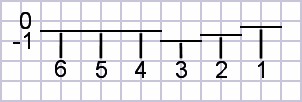 |
| Figure 2: Average compensated nut |
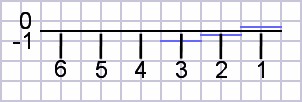 |
Custom and average saddle intonation
Since most straight saddles are slanted to pass through the closest intonation of each string, I decided to calculate a slanted average line through the ideal values. This is done by a calculation called a linear regression, available on some scientific calculators and some internet calculators as well. My first calculation produced equation 2 below. In the table that follows the G string exceeds and the A and D strings approach the reference error.| (2) |
compensationsaddle =
0.148571 × numstring + 1.58 |
| String Name |
|
String Number |
|
Δsaddle-optimal (mm) |
|
Δsaddle-average (mm) |
|
εsaddle (mm) |
|
εsaddle (cents)s |
| E | 1 | 1.3 | 1.728571 | 0.428571 | 1.141096 | |||||
| B | 2 | 2.1 | 1.877142 | –0.222858 | –0.593670 | |||||
| G | 3 | 3.1 | 2.025713 | –1.074287 | –2.863663 | |||||
| D | 4 | 1.5 | 2.174284 | 0.674284 | 1.794982 | |||||
| A | 5 | 1.7 | 2.322855 | 0.622855 | 1.658141 | |||||
| E | 6 | 2.9 | 2.471426 | –0.428574 | –1.141856 |
| Figure
3:
Linear
regression
plots
average
saddle
line
through
ideal
points. |
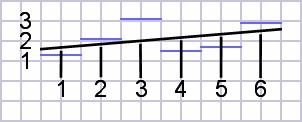 |
Comparison with special G compensation
With the realization that the G string is a difficulty, many saddles
are straight except for a customized G intonation. A calculation
without G produces equation 3
below which is more ideal for the other strings. G is now
presumed exactly correct. Now all intonation error is less than
that of a fifth interval.| (3) |
compensationsaddle =
0.186047 × numstring + 1.23023 |
| String Name |
|
String Number |
|
Δsaddle-optimal (mm) |
|
Δsaddle-average (mm) |
|
εsaddle (mm) |
|
εsaddle (cents) |
| E | 1 | 1.3 | 1.416277 | 0.116277 | 0.309669 | |||||
| B | 2 | 2.1 | 1.602324 | –0.497676 | –1.326036 | |||||
| G | 3 | 3.1 | 3.100000 | 0 | 0 | |||||
| D | 4 | 1.5 | 1.974418 | 0.474418 | 1.263122 | |||||
| A | 5 | 1.7 | 2.160465 | 0.460465 | 1.225985 | |||||
| E | 6 | 2.9 | 2.346512 | –0.553488 | –1.474808 |
| Figure 4: Linear regression plots average saddle line through all points except G. |
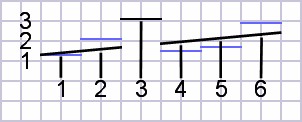 |
Example error of a misplaced bridge
My need to re-setup my guitar's intonation likely resulted from an
error in the factory placement of the saddle. Examination of my
guitar's saddle shows little or no additional intonation for
strings A and D. Therefore shifting the previous
compensation values forward by an amount producing correct intonation
for these strings (≈ –0.5mm) will allow evaluation of intonation error
that I considered objectionable. The result is excessive error
for the B and E(6) strings. G would have been worse if it had not
had a special factory setback.| Figure
5:
Custom
saddle
intonation
shows
little
additional
compensation
for
the
A
and
D strings. |
 |
| () |
compensationsaddle =
0.755812 × numstring + 1.23023 |
| String Name |
|
String Number |
|
Δsaddle-optimal (mm) |
|
Δsaddle-average (mm) |
|
εsaddle (mm) |
|
εsaddle (cents) |
| E | 1 | 1.3 | 0.941859 | –0.358141 | –0.954149 | |||||
| B | 2 | 2.1 | 1.127906 | –0.972094 | –2.591049 | |||||
| G | 3 | 3.1 | 2.625582 |
–0.474418 |
–1.264044 |
|||||
| D | 4 | 1.5 | 1.500000 | 0.000000 | 0.000000 | |||||
| A | 5 | 1.7 | 1.686047 | –0.013953 | –0.037163 | |||||
| E | 6 | 2.9 | 1.872094 | –1.027906 | –2.739930 |
| Figure
6:
Factory
compensation
in
error
by
≈
–0.5mm. |
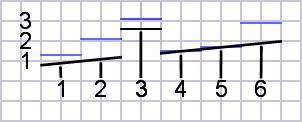 |
Final remarks
I have read that an intonation with correctly placed straight nut and
saddle (except for a G setback) is musically pleasing to all but a
few. Only some sensitive individuals.benefit from a custom
intonation. In my case I had the misfortune of a misplaced
bridge and the fortune that it was placed correctly for a custom
intonation to fall in the range of a normal saddle blank.Disclaimer: Principle is valid for all guitars, however the exact data will be different for non-classical ones.
|
|
1See related article: Custom Intonation.
Document History
March 15, 2018 Created.